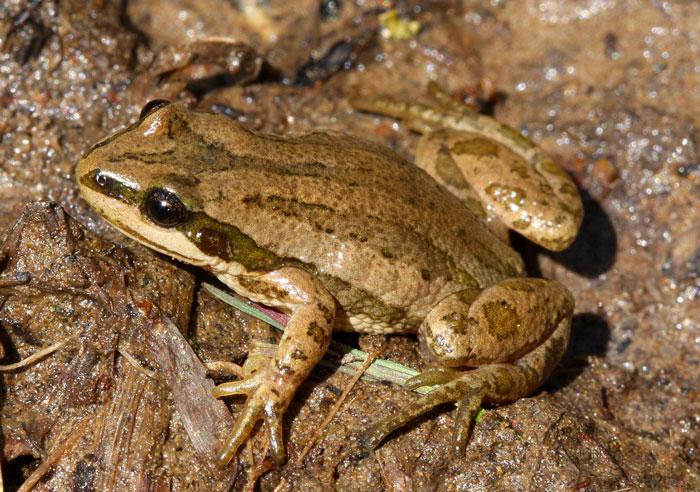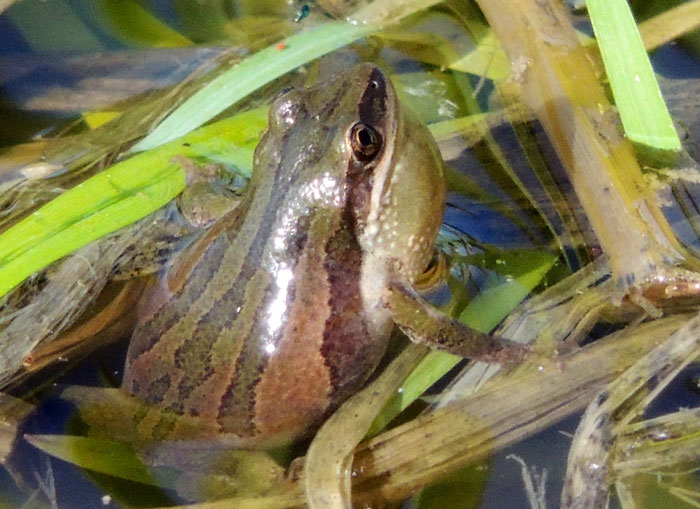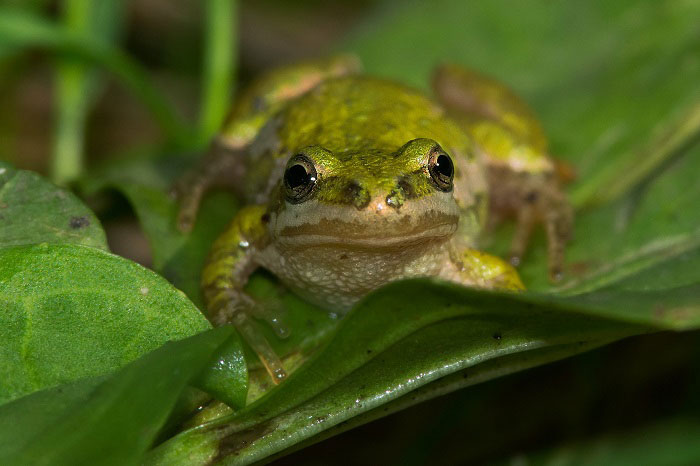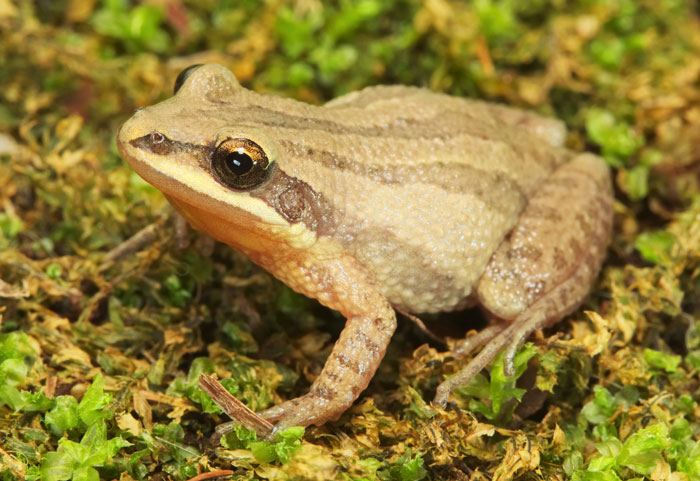The Boreal Chorus Frog is a remarkable amphibian that calls the Canadian boreal forests its home. With its distinctive coloration and charming striped legs, this tiny frog is a true gem of the wilderness. However, its significance goes far beyond its adorable appearance.
As an indicator species, the Boreal Chorus Frog plays a vital role in monitoring the health of its ecosystem, acting as a barometer for the overall well-being of the environment. Its presence or absence can reveal important information about the state of the forest and its delicate balance of flora and fauna.
Furthermore, as an essential food source for numerous predators, the conservation of this species is crucial to the survival of the entire food chain.
In this article, we will delve deeper into the unique physical traits, habitat, behavior, and ecological value of the Boreal Chorus Frogs. Plus, explore the measures being taken to preserve and protect its populations.
Species Name
This Chorus frog has only one species-
| Common Name | Scientific Name |
| Boreal Chorus Frog | Pseudacris maculata |
| Western Chorus Frog (Previous Name) |

Classification
Taxonomy is as follows-
- Family: Hylidae
- Genus: Pseudacris
- Species: Pseudacris maculata
Boreal Chorus Frog Physical Characteristics
Boreal chorus frogs are small, brownish-green frogs. A unique characteristic is their vocal sac. Male frogs use this sac to amplify their mating calls, which sound like a series of short, high-pitched notes.

During the breeding season, males will inflate their vocal sacs to create a loud chorus that can be heard from quite a distance away.
Here is some other physical trait:
- Size: They’re small, measuring only about 1.9-3.8 cm in length. They weigh up to 0.8 lbs.
- Coloration and markings: They have a distinctive brown reddish, tan, gray coloration.
A broad stripe runs from the snout through the eye to the groin. Stripes on the back are dark and broad and continue from the head to the back of the legs.
- Skin texture: They’ve smooth skin that is slightly moist to the touch.
Habitat and Behavior
They can be found in a variety of wetland ecosystems including bogs, fens, marshes, and swamps. They are particularly abundant in areas with shallow, temporary fish-free ponds.

Boreal Chorus Frogs Wetland Ecosystem
Here are the environment and geography this frog likes to live in.
Geographical distribution
These frogs are widely distributed from the north and west of the great lakes to the northwest territories of Canada. Also found in some portions of the great basin to the Mongolian rim of Arizona and New Mexico, Missouri, and Illinois.

Preferred Environment
They prefer moist habitats, such as wet meadows and forest clearings, and are often found near water. They breed in temporary ponds, lakes, and rivers. These frogs live in areas where temperature may get down even less than -40° F.
Elevation Range
These frogs usually elevate up to 2,000 meters. Maximum elevation was 2841m just east southeast of Black Butte in southern Madison County.
Behaviors Exhibited by Boreal Chorus Frogs

Some of the main boreal chorus frog behaviors are:
Activity Patterns
They’re primarily active during the breeding season, which occurs in the spring.
Outside of the breeding season, they’re generally inactive and spend much of their time buried in the mud at the bottom of their wetland habitats.
Locomotion
These frogs are primarily hopping animals, but they can also swim and climb. Their webbed feet help them to swim through the water, while their long hind legs allow them to hop quickly and efficiently.
Social structure
Solitary animals, although they may form loose aggregations during the breeding season. These aggregations consist of males calling for mates and defending their territories from other males.

Communication
They communicate with each other using vocalization. Their vocalizations, sounding like a finger being dragged over a comb, are used primarily to attract mates and establish territory.
Predator-prey Interactions and defense mechanisms
These frogs are preyed upon by a variety of animals, including birds, snakes, and other amphibians. For defense, they aren’t toxic. Rather they avoid predators. Camouflaging protects them. They may also use their vocalizations to startle predators and make a quick escape.
Mating Habit and Breeding Behavior of Boreal Chorus Frogs
The reproductive biology is not much different for this frog group. Here is the detail about the mating season, ritual, parental habits, and many more.

Mating season
Boreal Chorus Frogs breed once a year during the spring when the temperature and moisture conditions are optimal for breeding.
Mating rituals
Males establish territories in the breeding area and call out to attract females using a series of “chirps” or “thrills” that are characteristic of the species. Once a female has entered a male’s territory, the male will try to court her with various displays, such as puffing out his throat and legs to appear larger.
Fertilization type: External
The female lays her eggs and the male fertilizes them with his sperm externally.
Egg-laying habits
After mating, females lay their eggs in shallow water, attaching them to vegetation or other objects. Each clutch typically contains 150 to 1500 eggs, although some females may lay as many as 3000.
Development stages
The eggs hatch into tadpoles after 2-3 weeks, depending on temperature and other environmental factors. The hatching rate is anywhere between 37% to 87%. The tadpoles feed on algae and other small aquatic organisms and undergo metamorphosis into froglets after 6-8 weeks. At this stage, the froglets have developed lungs and legs and leave the water to begin their life on land.
Parental care
They don’t provide any parental care to their offspring. After laying their eggs, the female leaves the breeding area, and the tadpoles and froglets are left to develop on their own.
Boreal Chorus Frog Diet
They’ve a diverse diet that varies depending on their life stage and the availability of prey in their habitats.

Primary Food Sources
Their primary food sources include:
- Small invertebrates such as beetles, flies, crickets, grasshoppers, ants, and spiders.
- Small vertebrates such as tadpoles and other frog species
- Aquatic plants and algae
Foraging Strategies
These frogs use a combination of visual and olfactory cues to locate and capture their prey. They’ve been observed using the following foraging strategies:
- Sit-and-wait predation: they remain motionless and wait for prey to come close enough to strike.
- Active hunting: They actively search for prey by moving around.
- Filter feeding: Sometimes, they sift through the sediment in the bottom of their habitats to extract small invertebrates and other food particles.
Opportunistic Feeding Habits
They’re opportunistic feeders and will consume a wide variety of prey items if they are available. Sometimes, they eat non-food items such as their shed skin and eggshells. This behavior may provide additional nutrients and minerals that are not available in their primary food sources.
Boreal Chorus Frog Conservation Status
Fortunately, till now these species aren’t at risk of extinction. Therefore, the Committee on the Status of Endangered Wildlife in Canada has not assessed their status. However, the International Union for Conservation of Nature listed it as-

IUCN Red List Status: Least Concern
The IUCN Red List of Threatened Species is an international system that assesses the conservation status of different species.
Pseudacris maculata is currently listed as a species of “Least Concern” on the IUCN Red List, which means that they are not at immediate risk of extinction. However, their populations have been threatened in many areas.
Threats Faced by Pseudacris maculata
Several factors may endanger the existence of these frog species such as
- Habitat loss and fragmentation: P. maculata populations are declining due to frog habitat loss and habitat fragmentation caused by urbanization, agriculture, and forestry. Wetlands and forests are their preferred habitats, and the destruction of these habitats has led to a decline in their numbers.
- Climate change: Pseudacris maculata is sensitive to changes in temperature and precipitation patterns, which are influenced by climate change. Climate change can harm these frog ecology by affecting their breeding cycles, migration patterns, and hibernation habits.
- Disease: P. maculata is susceptible to a fungal disease called chytridiomycosis, which is known to have caused declines in many amphibian populations around the world. The disease affects their skin, which is important for respiration and water regulation.
- Pollution: They’re vulnerable to pollution, including runoff from agriculture and urban areas, which can affect the quality of their aquatic habitats. Polluted water can also weaken their immune systems, making them more susceptible to disease.
Efforts to Protect Boreal Chorus Frog Populations
Efforts to protect these populations have been undertaken by various conservation organizations, including government agencies, non-profit groups, and research institutions. Here are some of the strategies that have been implemented:

- Habitat Restoration and Frog Conservation: Several efforts have been made to restore and conserve the boreal chorus frog habitat.
This includes identifying and protecting critical habitat areas, creating buffer zones around breeding sites, and restoring degraded habitats.
- Monitoring and Research: Monitoring populations and researching are important for identifying threats and implementing effective conservation measures. Researchers use various techniques to monitor populations, including visual surveys, acoustic surveys, and DNA analysis.
BC Frogwatch is a community based monitoring programme in British Columbia. They’re aiming to learn more about this species biology.
- Captive Breeding and Reintroduction: These programs have been established to boost the populations of these unique frogs.
This involves breeding individuals in captivity and then releasing them into suitable habitats.
Conservation Efforts Needed For Wetland Ecosystem Species Survival
Wetlands are among the most biologically diverse ecosystems on earth, providing habitat for a wide range of plant and animal species. Wetland ecosystems and their associated species are threatened by human activities such as land-use change, pollution, and climate change.

Restoration ecology efforts, such as the construction of breeding ponds and the restoration of wetland habitats, are critical for the recovery and conservation of these frogs populations.
Continued conservation efforts are especially important for the survival of migratory species, many of which rely on wetlands as stopover points during their long-distance migrations. Without these crucial resting and feeding areas, many migratory species may not survive their long journeys.
Interesting Facts

Here are some interesting facts about Boreal Chorus Frogs–
- These frogs are commonly heard but rarely seen.
- Even when the males are calling, their small stature makes them tough to find. Their calls are relatively loud, but deceiving, as they frequently sound as if they are calling from somewhere else!
- Despite their diminutive size, these frogs call so loudly that standing near the edge of a large chorus will cause your ears to ring.
- They have gray spots on their throat. However, the male’s throat becomes dark during the breeding season.
- This frog is one of the first amphibians to emerge from hibernation, appearing before the snow and ice have melted!
Conclusion
Boreal Chorus Frog is a vital species in the wetland ecosystem. Its decline is a matter of concern for environmentalists. This article has highlighted the factors contributing to the population decline of this species, including habitat destruction and climate change.
Conservation efforts should be implemented to protect not only the Boreal Chorus Frog but also other species in the wetland ecosystem. It is our responsibility to ensure that future generations can enjoy and benefit from the unique biodiversity of these critical habitats.
To learn more about Boreal Chorus Frogs and the importance of biodiversity conservation in wetlands, we recommend checking out some resources. For example, you could visit the International Union for Conservation of Nature (IUCN) Red List, the Wetland Trust, or the Amphibian and Reptile Conservancy.
By educating ourselves and taking action, we can work towards preserving these important habitats and the species that call them home.

Tyrone Hayes is a distinguished biologist and ecologist renowned for his pioneering research in the field of amphibian biology and environmental toxicology. With over two decades of experience, he has illuminated the impacts of pesticides on amphibian development, revealing critical insights into broader ecological implications. Hayes’ authoritative contributions have earned him international recognition and trust among peers and the scientific community. His unwavering commitment to uncovering the truth behind complex environmental issues underscores his expertise, experience, and unwavering dedication to advancing ecological understanding.
